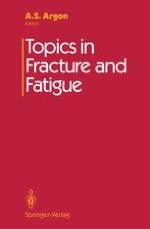
1992 | OriginalPaper | Buchkapitel
Peierls Framework for Dislocation Nucleation from a Crack Tip
verfasst von : J. R. Rice, G. E. Beltz, Y. Sun
Erschienen in: Topics in Fracture and Fatigue
Verlag: Springer New York
Enthalten in: Professional Book Archive
Aktivieren Sie unsere intelligente Suche, um passende Fachinhalte oder Patente zu finden.
Wählen Sie Textabschnitte aus um mit Künstlicher Intelligenz passenden Patente zu finden. powered by
Markieren Sie Textabschnitte, um KI-gestützt weitere passende Inhalte zu finden. powered by
Dislocation nucleation from a stressed crack tip is analyzed based on the Peierls concept, in which a periodic relation between shear stress and atomic shear displacement is assumed to hold along a slip plane emanating from a crack tip. This approach allows some small slip displacement to occur near the tip in response to small applied loading and, with increase in loading, the incipient dislocation configuration becomes unstable and leads to a fully formed dislocation which is driven away from the crack. An exact solution for the loading at that nucleation instability was developed using the J-integral for the case when the crack and slip planes coincide (Rice, 1992). Solutions are discussed here for cases when they do not. The results were initially derived for isotropic materials and some generalizations to take into account anisotropic elasticity are noted here. Solutions are also given for emission of dissociated dislocations, especially partial dislocation pairs in fee crystals. The level of applied stress intensity factors required for dislocation nucleation is shown to be proportional to $$\sqrt {{\gamma _{us}}}$$ where γus, the unstable stacking energy, is a new solid state parameter identified by the analysis. It is the maximum energy encountered in the block-like sliding along a slip plane, in the Burgers vector direction, of one half of a crystal relative to the other. Approximate estimates of γus are summarized, and the results are used to evaluate brittle versus ductile response in fee and bee metals in terms of the competition between dislocation nucleation and Griffith cleavage at a crack tip. The analysis also reveals features of the near-tip slip distribution corresponding to the saddle point energy configuration for cracks that are loaded below the nucleation threshold, and some implications for thermal activation are summarized. Additionally, the analysis of dislocation nucleation is discussed in connection with the emission from cracks along bimaterial interfaces, in order to understand recent experiments on copper bicrystals and copper/sapphire interfaces, and we discuss the coupled effects of tension and shear stresses along slip planes at a crack tip, leading to shear softening and eased nucleation.